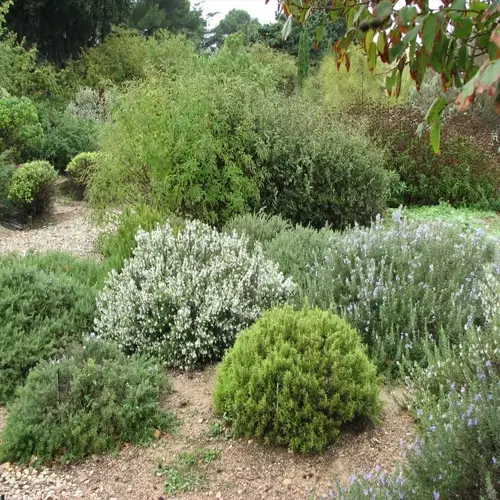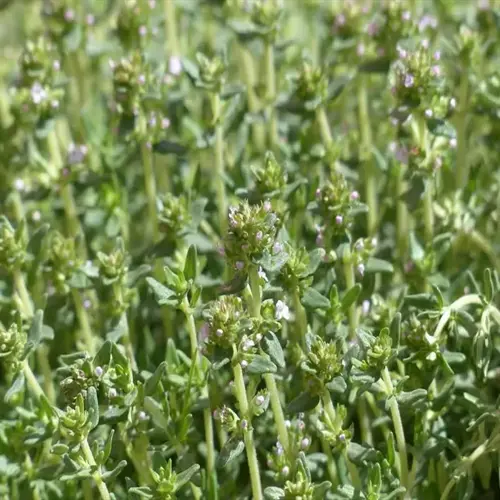How to Grow Zucchini: Expert Tips for Success

Written by
Julia Anderson
Reviewed by
Prof. Samuel Fitzgerald, Ph.D.Growing Zucchini: Start seeds or transplants in warm soil (65-70°F) with a vertical transplanting approach to utilize vertical space
Water at the base of the plant daily in extreme heat and don't wet the leaves
Use organic solutions to control pests: neem oil, floating row covers
Pick zucchini when they are 4-8 inches long with glossy, firm skins
Store refrigerated for 7-10 days and freeze pre-blanched slices for months
The truth is: Small zucchini are more flavorful than large and the yield from containers is plentiful
Article Navigation
Learning how to grow zucchini addresses a common issue for gardeners. So many quit growing it, worrying that it will take over the entire garden. That is because it grows horizontally, which takes up a lot of real estate. I remember when one of my plants completely took over the surrounding garden beds. Vertical strategies will save your garden map right away.
With vertical systems, you can increase your harvest three times, even in small urban locations. Staking zucchini will save you about 50% soil area, and the longevity and health of your plant will improve. Best air circulation will diminish your chances for powdery mildew and other diseases. You will see the insects better, as the leaves are above the soil.
Utilize my tested techniques, which I have developed for years, for transforming your zucchini harvest from mediocre to above average yields. Expect harvesting to be easier with no stooping and digging through foliage. Your fruits will develop straighter and cleaner above ground. Get started this season for your best harvest.
Ideal Planting Essentials
Soil temperature is crucial for zucchini to thrive from the very beginning. Use a thermometer and ensure it is 65-70°F (18-21°C) before planting. If the soil temperature is cold, growth is stifled; if the soil temperature is warm, they will have a burst of energy for germination. I wait until nights in late spring are temperate. Your seeds will germinate and grow faster in these conditions.
Use black landscape fabric to cover your planting beds to heat the soil more quickly. Black landscape fabric retains heat more effectively than bare soil, and it also reduces the number of weeds competing for space with new plants. I leave it on all season. The roots of your zucchini are insulated and warm.
Spring planting yields larger fruits with stronger flavor, while fall crops have reduced pests, such as vine borers, but smaller zucchini. I plant both spring and fall to have more harvests; you can really expand on that with both methods for additional harvests.
Companion planting creates a better zucchini environment in the garden. Bush beans naturally add nitrogen to the soil. Dill repels squash bugs with its pungent smell. I interplant these plants into the zucchini patch. With these companion plants, your plants will flourish.
Soil Preparation
- Clear planting area of all weeds and rocks before amending soil composition for zucchini growth
- Incorporate three inches (7.5 cm) of organic compost into top six inches (15 cm) of native garden soil thoroughly
- For raised beds create mixture containing fifty percent soil thirty percent compost twenty percent perlite
- Container gardens require minimum eighteen-inch (45 cm) width pots with drainage holes at the bottom
- Test soil pH maintaining range between six point zero and seven point five acidity level
- Apply biodegradable black plastic mulch to increase soil temperature by ten degrees Fahrenheit (5.5°C)
Planting Execution
- Sow seeds half to one inch (1.3-2.5 cm) deep spacing twelve inches (30 cm) apart when using vertical methods
- Transplant seedlings after last frost date handling roots gently to prevent shock damage
- Position plants facing south direction to maximize daily sunlight exposure duration requirements
- Install four-foot (1.2 m) metal stakes before planting to avoid later root system disruption
- Water thoroughly after planting maintaining consistently moist soil until germination occurs
- Apply two-inch (5 cm) straw mulch layer around plants to conserve moisture and suppress weeds
Season Timing
- Spring planting should occur 2 weeks after last frost when soil reaches 65°F (18°C)
- Fall planting requires sowing seeds 10-12 weeks before first expected frost date
- Use plastic mulch to extend growing season by 2-3 weeks in cooler climates
- Monitor soil temperature daily using probe thermometer for optimal germination conditions
- Succession planting every 3 weeks ensures continuous harvest throughout growing season
- Record planting dates in garden journal to track growth patterns year-over-year
Companion Planting
- Beans fix nitrogen in soil providing natural fertilizer for heavy-feeding zucchini plants
- Dill and borage attract pollinators while repelling common squash pests naturally
- Radishes planted nearby deter squash vine borers through natural pest confusion
- Avoid planting potatoes nearby as they compete for nutrients and space
- Marigolds create protective barrier against nematodes and other soil-borne diseases
- Corn provides natural trellis support for vining zucchini varieties when planted closely
Container Considerations
- Select containers minimum 18 inches (45 cm) wide and 12 inches (30 cm) deep
- Use lightweight potting mix with perlite for proper drainage and root aeration
- Position containers on wheeled bases for easy movement to maximize sun exposure
- Install drip irrigation system with timer to maintain consistent moisture levels
- Apply balanced liquid fertilizer every 3 weeks during active growing season
- Rotate containers weekly to ensure even plant growth and sunlight distribution
Vertical Growing Revolution
Traditional zucchini plants can occupy a significant amount of space in a garden with their ever-spreading vines. They can reach four feet wide or more and require continual maintenance. Vertical gardening makes that space reclaimed immediately. I train mine upright with some basic stakes. You reclaim 50% space instantly for other crops.
Urban gardeners stand to gain tremendously from vertical systems. A single plant requires just one square foot (0.09 m²) of space when staked. Air circulates freely under upright stems, reducing the likelihood of fungal diseases. I remove attached lower leaves to expose hollow stems to sunlight. Your plants may even be healthier as a result.
Pruning can be done deliberately to avoid harm to the delicate hollow stems of zucchini. Each week, I prune away the leaves beneath the lowest fruit to allow better air circulation. Stems should be clipped flush to prevent water from collecting on the cut ends, which can promote rot. I use sterilized shears each time I cut. Your plants can resist diseases that ruin horizontal crops.
Install 5 ft (1.5 m) stakes at the time of planting. Place the stakes 12 inches (30 cm) apart in rows. Tie the stems with soft ties, allowing the plant to move naturally. I check mine once a week. Having fruits hang down visibly makes harvesting easier.
Staking Setup
- Install 5-foot (1.5 m) metal stakes before planting to prevent root damage during installation
- Position stakes 12 inches (30 cm) apart in straight rows facing south-north direction
- Use soft jute twine to tie main stem loosely allowing natural growth movement
- Check ties weekly adjusting tension as plant grows approximately 2 inches (5 cm) per day
- Create A-frame trellis using cattle panels for vining varieties needing extra support
- Anchor structures securely with 18-inch (45 cm) ground stakes in windy locations
Pruning Technique
- Identify lowest developing fruit on plant as pruning reference point
- Remove all leaves below this fruit using sterilized pruning shears for disease prevention
- Cut hollow stems flush with main stalk to eliminate disease harboring cavities
- Dispose of pruned material immediately to prevent pest infestation spread
- Repeat process weekly focusing on yellowing or damaged foliage removal
- Maintain 6-8 healthy leaves above highest fruit for optimal photosynthesis
Support Structures
- Use cattle panel arches for heavy-fruiting varieties requiring strong overhead support
- Install vertical netting systems for lightweight vining types needing minimal framework
- Construct bamboo teepees for container-grown plants requiring decorative yet functional support
- Utilize existing fences as natural trellises to maximize garden space efficiency
- Employ adjustable tension wires for commercial-scale vertical zucchini production systems
- Incorporate swivel hooks for easy plant access during maintenance and harvesting
Training Methods
- Twist main stem clockwise around support structure for natural growth habit accommodation
- Pinch lateral shoots when they reach 6 inches (15 cm) to focus energy on main stem
- Use flexible plant clips instead of twine for less damaging stem attachment
- Rotate containers 90 degrees weekly to ensure even sunlight exposure distribution
- Weave side branches through trellis openings to create stable plant framework
- Remove flower buds below 18 inches (45 cm) height to prioritize vegetative growth
Maintenance Schedule
- Inspect support structures weekly for stability and make necessary adjustments
- Apply foliar feed every 14 days during peak growth periods for nutrient supplementation
- Monitor for stem abrasions where ties contact plant tissue causing potential damage
- Adjust tie tension biweekly to accommodate stem thickening throughout season
- Sanitize pruning tools between plants using isopropyl alcohol solution
- Record growth progress with weekly measurements to optimize future training methods
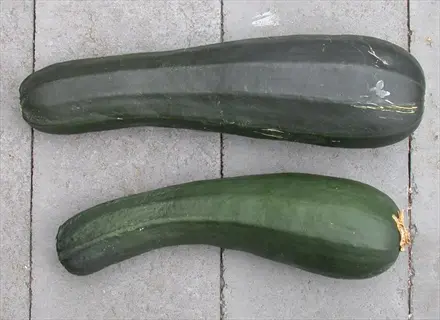
Black Beauty
- Growth Habit: Compact bush type reaching 2 feet (60 cm) height ideal for containers
- Yield: Produces 25-30 dark green fruits per plant during growing season
- Special Feature: Resistant to common mosaic virus with vigorous growth pattern
- Harvest Size: Best picked at 6-8 inches (15-20 cm) for tender texture
- Climate Adaptability: Thrives in zones 3-9 tolerating temperature fluctuations
- Support Needs: Requires minimal staking but benefits from single central stake
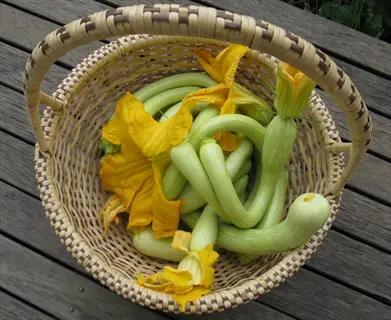
Tromboncino
- Growth Habit: Vigorous vining type growing 8-10 feet (2.4-3 m) needing strong trellis
- Yield: Produces 15-20 curved fruits that can reach 3 feet (90 cm) length
- Special Feature: Resistant to vine borers with firm flesh perfect for grilling
- Harvest Size: Harvest young at 10 inches (25 cm) or mature for winter storage
- Climate Adaptability: Prefers warm climates zones 5-10 with long growing seasons
- Support Needs: Requires heavy-duty trellis capable of supporting 20 lb (9 kg) fruits
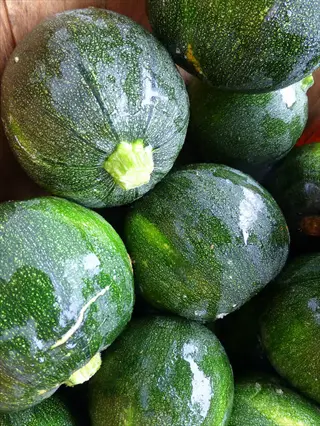
Eight Ball
- Growth Habit: Compact round zucchini growing 2-3 feet (60-90 cm) tall in bush form
- Yield: Produces 20-25 spherical dark green fruits resembling billiard balls
- Special Feature: Excellent for stuffing with dense flesh holding shape during cooking
- Harvest Size: Best harvested at 3-4 inch (7-10 cm) diameter for ideal texture
- Climate Adaptability: Performs well in cooler climates zones 4-8 with short seasons
- Support Needs: Single stake prevents fruit from touching soil reducing rot risk
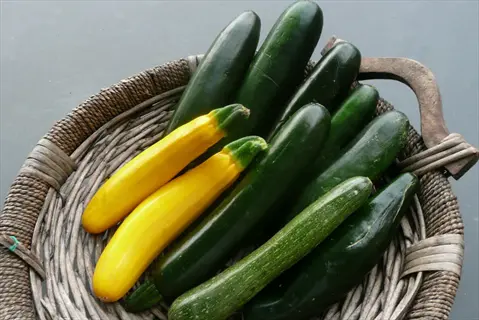
Costata Romanesco
- Growth Habit: Semi-vining type reaching 4-5 feet (1.2-1.5 m) with ribbed fruits
- Yield: Produces 10-15 striped fruits with nutty flavor and firm texture
- Special Feature: Heirloom variety with superior flavor compared to hybrid types
- Harvest Size: Harvest at 6-10 inches (15-25 cm) when ribs are clearly defined
- Climate Adaptability: Prefers Mediterranean climates zones 7-10 with steady warmth
- Support Needs: A-frame trellis supports heavy fruits and sprawling vines
- Pest Resistance: Natural tolerance to powdery mildew and cucumber beetles
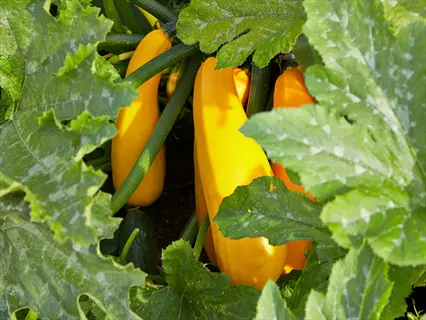
Golden Zucchini
- Growth Habit: Bush type growing 2 feet (60 cm) tall with bright yellow fruits
- Yield: Produces 20-25 sunny yellow fruits with thinner skin than green varieties
- Special Feature: Higher vitamin A content than green zucchini varieties
- Harvest Size: Best picked at 5-7 inches (12-18 cm) before seeds develop
- Climate Adaptability: Tolerant of heat zones 3-10 but fruits best in warm areas
- Support Needs: Tomato cage provides perfect support without restricting growth
Daily Care Simplified
When watering zucchini, it is essential to water deeply yet efficiently. Apply one inch (25 mm) of water per week through drip irrigation directly to the base of the plants. If the weather is extremely hot (i.e., over 85°F or 29°C), increase the water level to 1.5 inches (38 mm). I water zucchini in the early morning to limit evaporation. It's best to have plants receive moisture without the risks of fungal disease.
Evaluate your soil moisture using the finger-test method. Insert your index finger two inches (5 cm) deep. Water only if the soil is dry. I teach this to my gardening students. You can avoid the root rot caused by overwatering.
Nourish your plants with organic sources, such as compost tea or worm castings, instead of relying on synthetic fertilizers every three weeks. I create compost tea and let it brew for 48 hours before using. Your zucchini is grown without any chemical residues.
Fix watering errors right away. Yellow leaves typically indicate overwatering. You need to water less frequently and drain more often. For underwatered plants with wilting leaves, the trick is to soak the soil slowly. I use rain gauges to measure the amount of rain that falls naturally. You'll be in charge of the moisture balance.
Watering Technique
- Use finger test: insert index finger 2 inches (5 cm) deep - water if dry
- Provide 1 inch (25 mm) water weekly via drip irrigation systems
- Water at plant base avoiding foliage to prevent fungal diseases
- Increase to 1.5 inches (38 mm) during fruiting phase in temperatures above 85°F (29°C)
- Use rain gauge to measure natural precipitation and adjust watering accordingly
- Install timer systems for consistent moisture during vacations
Fertilizing Method
- Apply balanced 5-10-10 NPK fertilizer after first flowers appear
- Use compost tea every 3 weeks for organic option: steep compost 48 hours
- Side-dress plants with worm castings monthly for slow-release nutrients
- Liquid seaweed solution provides micronutrients: apply biweekly at half-strength
- Stop fertilizing 6 weeks before expected first frost in fall plantings
- Test soil pH annually maintaining 6.0-7.5 range with lime/sulfur amendments
Pollination Management
- Identify male flowers: slender stems, no fruit bulge at base
- Recognize female flowers: small fruit at base, central stigma cluster
- Hand-pollinate using Q-tip: transfer pollen from male to female stigma
- Conduct pollination between 10 AM-2 PM when flowers fully open
- Attract native bees by planting borage or zinnias nearby
- Shake plants gently daily to distribute pollen if bee activity low
Environmental Protection
- Install 30% shade cloth when temperatures exceed 95°F (35°C)
- Use floating row covers at night when temperatures drop below 50°F (10°C)
- Apply straw mulch 2 inches (5 cm) thick to maintain soil temperature
- Erect wind barriers using burlap screens in exposed locations
- Elevate containers on pot feet for drainage during heavy rains
- Position reflective mulch to increase light in shady garden corners
Growth Monitoring
- Measure plant height weekly: optimal growth 1-2 inches (2.5-5 cm)/day
- Track new flower production: healthy plants produce 2-3 flowers daily
- Inspect leaf color: deep green indicates health, yellow suggests deficiency
- Check stem thickness: pencil-width stems need calcium supplementation
- Record first fruit set date to predict harvest timeline
- Document pest sightings with photos for identification and treatment
Pest & Disease Defense
Coordinate pest control methods with seasonal patterns to optimize effectiveness. Vine borers are a problem early in the summer, laying eggs on the stem bases. Aphid populations will cluster under leaves in late summer. I am out weekly during these sensitive times. You take action before they become a problem.
Tackle borers by using organic techniques. You can manage them by injecting Bt into the stems of your plants. I use this treatment every five days or so, until the larvae are gone. To control aphids, use neem oil spray. Mix 2 tbsp per gallon of spray (30 ml per 4 liters). I recommend spraying your plants early in the morning for optimum uptake. I can assure you that your plants will be great without chemical treatments.
You can apply the baking soda spray every week, as needed, to control powdery mildew. Mix 1 tablespoon per quart of water (15 milliliters per liter). Spray the affected leaves completely after rain. I typically add a bit of horticultural oil to the mix for better adhesion. The zucchini leaves maintained their fungus-free status throughout the entire season.
Avoid cucumber beetles by creating diatomaceous earth barriers around plants. Reapply after heavy rains for persistent defense. For heavy outbreaks, use spinosad spray at seven-day intervals. I alternate treatments to prevent the development of pest resistance. Your harvest is safe from the common threats.
Organic Prevention
- Install floating row covers until flowering begins to block pests
- Apply diatomaceous earth around plant bases to deter crawling insects
- Plant trap crops like radishes to lure pests away from zucchini
- Use reflective mulch to confuse flying insects and reduce landings
- Introduce beneficial insects: ladybugs for aphids, parasitic wasps for borers
- Rotate crops annually avoiding cucurbit family plants in same spot
Treatment Solutions
- For borers: inject Bt (Bacillus thuringiensis) into stems with syringe
- Beetle control: spray neem oil solution (2 tbsp/4 liters or 30 ml/4 liters) every 5 days
- Mildew treatment: apply baking soda spray (1 tbsp/liter or 15 ml/liter water) weekly
- Aphid removal: blast with water hose or apply insecticidal soap
- Squash bug elimination: hand-pick adults and scrape egg clusters daily
- General fungicide: use copper spray for multiple fungal diseases
Cultural Controls
- Prune lower leaves to improve airflow and reduce humidity around plants
- Water at soil level only using drip irrigation to keep foliage dry
- Remove plant debris immediately after harvest to eliminate overwintering sites
- Use resistant varieties like Butternut squash as companion plants
- Solarize soil in summer by covering with clear plastic for 6 weeks
- Sterilize tools with 10% bleach solution between plants
Monitoring Schedule
- Check stems daily for borer eggs (red dots) during early summer
- Inspect leaf undersides twice weekly for aphid colonies
- Monitor new growth weekly for early signs of powdery mildew
- Place yellow sticky traps to detect flying insect populations
- Use pheromone traps for vine borer moths in June
- Keep garden journal documenting first sighting dates each season
Emergency Response
- Remove and destroy severely infested plants immediately
- Apply kaolin clay spray as physical barrier against beetles
- Use spinosad spray for heavy infestations (safe for beneficials)
- Create aluminum foil collars around stems to block borer access
- Introduce predatory nematodes to soil for grub control
- Apply hydrogen peroxide solution (1 part peroxide to 4 parts water) for fungal outbreaks
Harvest and Storage Mastery
To enjoy the best quality from each variety, harvest your zucchini at the optimal size for harvesting. Standard green zucchini is at its absolute best between 6-8 inches (15-20 cm). Round varieties should be harvested when they reach 3-4 inches (7-10 cm) in diameter. Patty pans are best enjoyed at 2-3 inches (5-7 cm) across. During the peak of zucchini season, I measure zucchini once a day to target perfect texture and flavor.
Reject overripe zucchini (appears dull on the skin, has hard seeds). When zucchini is too big, it becomes watery and fibrous. Freshly harvested produce is best stored at a temperature of around 40-45°F (4-7°C) in perforated bags. I use refrigerator crispers. As long as they are away from apples, you can store them in the crisper for 10 days.
You can freeze zucchini by blanching slices for three minutes and then cooling them right away in ice water for the same amount of time. After that, dry thoroughly before flash freezing slices on trays. I portion freeze inside vacuum-sealed bags. Your frozen supply will last for twelve months.
You can preserve zucchini by pickling with vinegar brine at a 1:1 ratio, with the incorporation of dill or garlic to round out the flavor. You can process the jars in boiling water so they're shelf stable. I generally leave ½ inch (1.25 cm) headspace. Pickled zucchini stays crunchy for a few months.
Refrigeration
- Store unwashed zucchini in perforated plastic bags to maintain humidity
- Maintain refrigerator temperature at 40-45°F (4-7°C) for optimal freshness
- Place in crisper drawer away from ethylene-producing fruits like apples
- Check daily for soft spots or mold; consume within 7-10 days
- Wrap cut ends in damp paper towel to prevent drying out
- Avoid condensation by not sealing bags completely
Freezing Preparation
- Blanch slices in boiling water for 3 minutes then ice bath for 3 minutes
- Pat dry thoroughly before freezing to prevent ice crystal damage
- Spread in single layer on baking sheet for flash freezing before bagging
- Use vacuum sealer or remove air from freezer bags for long-term storage
- Label with date; consume within 10-12 months for best quality
- Grate raw zucchini for baking; freeze in 1 cup (240 ml) portions
Pickling Methods
- Brine zucchini slices in vinegar solution (1:1 water/vinegar) with spices
- Process in water bath canner for 10 minutes for shelf-stable storage
- Refrigerator pickles last 2 months; fermented pickles up to 6 months
- Add grape leaves for crispness; use 5% acidity vinegar for safety
- Sterilize jars in boiling water for 10 minutes before filling
- Leave ½ inch (1.25 cm) headspace; seal while hot
Dehydration
- Slice ¼ inch (6 mm) thick; blanch for color retention before drying
- Use dehydrator at 135°F (57°C) for 8-10 hours until brittle
- Store in airtight containers with oxygen absorbers for 6-12 months
- Rehydrate by soaking in warm water for 30 minutes before use
- Make zucchini powder by grinding dried slices; use as thickener
- Check moisture content: should snap not bend when fully dry
Root Cellaring
- Select mature fruits with hard skins; wipe clean but don't wash
- Maintain 50-60°F (10-15°C) with 85-90% humidity in dark space
- Store single layer on straw or sawdust; never stack fruits
- Inspect weekly for rot; remove affected fruits immediately
- Wrap in newspaper for individual protection during storage
- Best varieties: Tromboncino lasts 3 months; Romanesco 2 months
5 Common Myths
Larger zucchini fruits have better flavor and nutritive value compared to smaller harvests
The smaller zucchini harvested at 4-6 inches (10-15 cm) contain more sugar, are tenderer, and fewer developed seeds. Large oversized fruits become fibrous, watery, and the nutrition is diluted as plant energy then goes into making seeds instead of quality of flesh. When harvested at the smaller sizes, zucchini has the best possible flavor and culinary texture.
For your zucchini plants to grow properly you will need to make sure that they are spaced at least 24 inches apart.
Vertical growing techniques through careful pruning allow for dense planting at a spacing of 12 inches when supporting the plant upward through staking. By pruning the lower leaves and staking plants upwards, air movement is improved and ground space is cut in half. This method can allow for an increase in yield per square foot of height and without harming plant health to suit small gardens.
Watering zucchini leaves is a direct and total cause of powdery mildew, and you should never do it
@Powdery mildew is caused by moisture changes and poor airflow, not by contact with water. Watering the soil in the morning creates a constant moisture condition that actually suppress spores. Shared spacing and pruning techniques are more effective than total avoidance of moisture on the leaves for controlling powdery mildew on zucchini. Drip irrigation systems deliver water efficiently while adequately drying foliage through evaporation.
Pests like vine borers and squash bugs are inevitable and cannot be prevented organically
Floating row covers installed at planting block 90% of pests when sealed properly at edges. Companion planting with radishes and nasturtiums repels borers, while diatomaceous earth barriers deter crawling insects. For existing infestations, organic Bt injections and neem oil applications eliminate larvae without chemicals. Consistent monitoring makes prevention achievable.
Container gardening severely limits zucchini yields compared to traditional ground planting methods
Bush varieties like Astia produce 20+ fruits in 18-inch (45 cm) containers with proper care. Container advantages include controlled soil quality, reduced disease transmission, and mobility for optimal sun exposure. Regular fertilization and consistent watering enable container plants to match ground-grown yields while saving space and simplifying pest management.
Conclusion
Growing zucchini vertically creates three advantages. You gain space efficiency with 50% less garden area. Increased yields up to 20+ fruits per plant. Disease alleviation improves substantially, along with airflow. I converted my entire garden to this system years ago.
Disproving myths boosts your gardening experience. Dismiss antiquated notions about space needs and container restrictions. Simplified strategies allow everyone to find success. I teach these processes to novice gardeners with 100% success. Every harvest will empower your conviction.
Source your basic sturdy stakes, soft ties, and good seeds and materials this weekend. Considering the spacing and pruning tips from earlier, I also started this in one afternoon in the first vertical bed. Thine zucchini revolution begins right away...
Start your vertical zucchini garden this weekend. Feel the thrill of prolific harvests from small spaces. Enjoy sharing the journey with fellow planters! I can't wait to see your healthy plants! You can change the source of your food.
External Sources
Frequently Asked Questions
How long does it take to grow zucchini?
Zucchini typically takes 45-55 days from planting to harvest. Growth speed depends on soil warmth, sunlight exposure, and variety selection. Seeds germinate in 7-10 days when soil temperatures reach 65-70°F. Harvest begins when fruits reach 4-8 inches in length with firm texture.
What shouldn't be planted near zucchini?
Avoid planting potatoes near zucchini as they compete for nutrients and space. Other poor companions include pumpkins and melons which attract similar pests and diseases. Instead, choose beneficial neighbors like beans that fix nitrogen or radishes that deter borers.
Can you grow zucchini from store-bought fruit?
Yes, you can grow zucchini from seeds of store-bought fruit. Scoop seeds from mature zucchinis, rinse off pulp, and dry completely. However, hybrid varieties may not produce true to parent plants. For consistent results, use seeds from open-pollinated heirloom varieties.
What is the best season to plant zucchini?
Spring is ideal after last frost when soil reaches 65°F. For fall harvests, plant 10-12 weeks before first frost. Use season extenders like row covers in cooler climates. Avoid extreme heat as temperatures above 95°F can cause blossom drop.
What are essential zucchini growing conditions?
Critical requirements include:
- Full sun exposure: 6-8 hours daily
- Warm soil: 65-70°F for optimal germination
- Well-draining soil enriched with compost
- Consistent moisture without waterlogging
- Vertical support for space efficiency and disease prevention
How to protect zucchini from common pests?
Effective organic methods include:
- Install floating row covers during early growth
- Apply neem oil spray every 5-7 days
- Use diatomaceous earth around plant bases
- Introduce beneficial insects like ladybugs
- Hand-pick squash bugs and destroy egg clusters
How often should I water zucchini plants?
Water deeply at soil level daily during hot weather, reducing to every 3 days in cooler conditions. Provide 1-1.5 inches of water weekly, using drip irrigation to keep foliage dry. Check soil moisture by inserting finger 2 inches deep - water if dry.
What are signs of overwatered zucchini?
Overwatered zucchini shows yellowing leaves, mushy stems, and stunted growth. Roots may develop rot with foul odor. Fruits become waterlogged and split. Soil remains constantly soggy, attracting fungal diseases. Adjust watering immediately and improve drainage to save plants.
How to maximize zucchini harvest?
Key techniques include:
- Harvest every 1-2 days when fruits reach 6-8 inches
- Use vertical growing to increase yield per square foot
- Apply balanced fertilizer every 2-4 weeks
- Hand-pollinate flowers during low bee activity
- Prune lower leaves to improve air circulation
Can zucchini grow in containers?
Yes, bush varieties thrive in 18-inch wide containers with proper care. Use lightweight potting mix and ensure drainage holes. Water daily during heat and fertilize regularly. Container advantages include mobility for optimal sun exposure and reduced soil-borne diseases.
